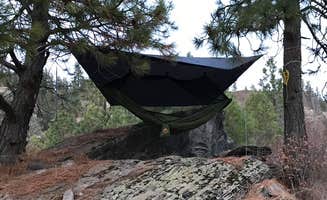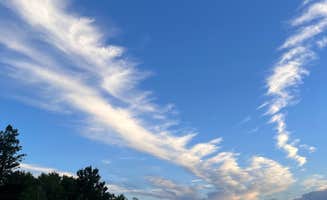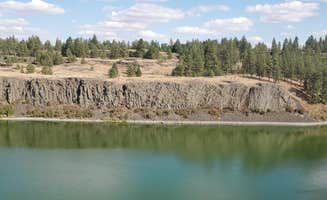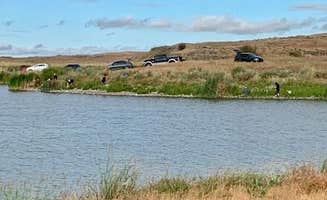Dispersed camping near Glenwood, Washington provides access to the dramatic, arid scablands of Eastern Washington. This region, shaped by massive ice-age floods, features basalt outcroppings, sagebrush steppes, and elevations ranging from 1,500 to 2,000 feet. Summer temperatures frequently exceed 90°F, while winters drop below freezing, creating distinct seasonal camping considerations.
What to do
Wildlife viewing opportunities: At Hog Lake Campground, campers can spot diverse wildlife throughout the day and night. "The hike is pleasant and the view is pretty awesome. Pet friendly and honestly it doesn't feel like this place is well known," reports one reviewer. Early morning and sunset hours offer the best wildlife spotting conditions.
Stargazing sessions: The minimal light pollution makes this region ideal for night sky viewing. At Riparia, campers experience exceptional stargazing conditions. "Absolutely no electricity here, not even for park lights. This makes for AMAZING star gazing," notes a visitor who appreciates the complete darkness.
Waterfall hikes: Several camping areas offer access to seasonal waterfalls within a 3-mile hiking distance. "A three mile hike/horseback ride takes you through Washington's Channeled Scablands to Towell Falls through spectacular buttes and meadows along the creek," shares a camper who explored the unique geology.
What campers like
Dark night skies: Free dispersed camping areas around Glenwood feature exceptional stargazing opportunities. A visitor to Escure Ranch / Rock Creek Recreation Area describes their experience: "The drive back was even amazing with the Sunset and landscape making me feel like I was on another planet. The best part was pure luck as I setup camp on the road back during a new moon which was perfect for star gazing and astro photography."
Wildlife sounds: Many campers mention the natural soundscape as a highlight. "At night it is in complete darkness, away from traffic noise, and you can hear the coyotes as they move nearer (I know, a little creepy, but making a little noise is all you need to do)," reports a visitor to the region.
Accessible sites: Some campgrounds offer good accessibility options. "It is very flat and would be reasonably accessible for someone using a wheelchair or with other mobility restrictions. The picnic tables are even accessible!" notes a camper about certain BLM campsites.
What you should know
Road conditions: Many free camping areas require driving on rough dirt roads. At Cow Lake, "The road here is dirt and the last mile or so is pretty rough. But, most vehicles shouldn't have any problems," according to a recent visitor.
Water availability: No drinking water exists at most dispersed sites. "There's no portable water for humans, so bring your own," warns a camper. Plan to carry all water needed for cooking, drinking, and cleaning.
Seasonal considerations: Spring offers wildflowers but also brings wildlife concerns. "The best time to visit is in the spring when the wildflowers are in bloom and before the rattlesnakes get populous," advises a regular visitor to the area's free camping spots.
Limited amenities: Most free camping near Glenwood offers minimal facilities. "There is a pit toilet, picnic tables, fire rings, corrals and horse water. The camping itself is on the primitive side, but the scenery it magnificent!" explains a camper about the typical setup.
Tips for camping with families
Choose shaded sites: The exposed landscape offers limited natural shade. At Fishtrap Recreation Area, "Not many spots with shade. The one that we did find had a lot of garbage around it. There were some dumpsters by the trail heads and bathrooms," reports a family that visited during summer.
Plan for challenging tent setups: Rocky terrain makes tent placement difficult. "I will advise tent campers it is tent accessible but not the easiest spot in a tent. The soil is very dry and a couple of the spots were hard rocks and not accessible for tents," notes a camper who brought their tent.
Bring bug protection: Insects vary seasonally but require preparation. "Bring bug spray! Day time the bugs aren't bad but, when the sun starts going down, the mosquitoes are coming out. Also, spring into early summer, there are ticks," warns a visitor who experienced the local insect life.
Tips from RVers
Seek level parking areas: The uneven terrain requires careful site selection. At Bonnie Lake Island, finding flat areas is critical: "The island is rocky and brushy with enough flat spaces for a tent or two and trees for hammocks." Similar terrain challenges exist at other dispersed camping areas around Glenwood.
Plan for dusty conditions: Dry conditions affect vehicles and equipment. "Your trailer, tow vehicle and anything in the bed is going to get dusty getting here and leaving. It's a decent trek down a gravel road," warns an RVer who regularly visits the region.
Monitor seasonal road access: Spring conditions may limit accessibility for larger rigs. "We have a 21ft trailer towed behind a pickup truck and it's able to fit in most spots. None of these are really official spots (not flattened or bordered) but it's a nice place to pass through," reports an RVer about the typical dispersed camping setup in the area.







